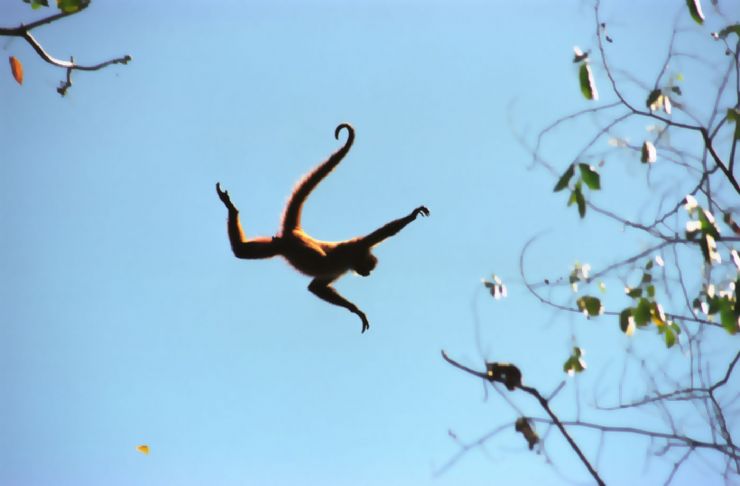
Flying Spider Monkey
When you visit Costa Rica, you are visiting a country that is so devoted to preserving its own natural environment that 25% of its land is designated as a protected, national park or reserve. That means that the land will never be torn up or torn down for development. That there won’t be deforestation or logging that leaves the land bare. That there won’t be commercial real estate, parking lots, or apartment buildings replacing the lush green forests and displacing the wildlife species that call those areas home.
What I love about my home country is that no matter where I traveling to or from, I am able to access a park or reserve. This was the deliberate plan of the scientists and Quakers that are responsible for leading the charge and preserving the land. They want to make sure that the animals could migrate through protected lands, and as an added consequence, the connecting lands are extremely accessible to curious creatures like you and I! Though I admit my travels have been limited to Costa Rica only, I know that there is no place in the world that I would love more or that would surround me in settings that are so beautiful and natural. My home might be considered just a small Latin American country, but it packs one of the biggest diversity punches in the world. In fact, for every 10,000 sq km of land in the country, there are over 600 wildlife species. That is incredible! And it is thanks to the preserved land that houses 12 different ecological zones. Scientists, naturalists, and students from all over the world find themselves amazed by Costa Rica, agree that this type of habitat calls to mind Eden, from the Bible.
.jpg)
Manuel Antonio National Park Sign
7 Days / 6 Nights
Starting at $779 per person
The emphasis on environmental protection, and ecotourism that is sustainable, that serves policies in Costa Rica have gained worldwide attention, and have inspired other countries to remodel their environmental protection policies. By protecting the land with pure intentions of preservation, Costa Rica has proven that doing right for the environment doesn’t have to hurt tourism. In fact, millions of tourist travel to Costa Rica each year because of the environment that the country has sustained. This tourism provides a great boost to the country’s economy each year. The more scientists explore and discover Costa Rica and all of its right habitats, the more they emphasis and share the park and reservation model with other destinations around the world.
Though it was no small feat, the heroes that fought for conservations and preservation in Costa Rica would be proud to see that today, there are 26 official National Parks in Costa Rica. The system does have a governing body; a department of Costa Rica's Ministry of Environment and Energy (MINAE) called SINAC (Sistema Nacional de Areas de Conservacion). In addition to the 26 official parks, Costa Rica also has some other pretty impressive statistics:
- 58: The number of wildlife refuges that work toward conservation and preservation.
- 32: Areas, or zones, that are officially protected and ban any type of development or destruction.
- 15: The number of different wetland areas and mangroves that exist in Costa Rica, adding to its unique biodiversity.
- 11: There are eleven forest reserves in Costa Rica, which means those trees will be there for me to climb in forever, since no one will be cutting them down for logging.
- 8: The number of biological reserves that are protecting land, plants, and animals alike.
- 12: Regions of additional conservation that works to keep the distinctly unique habits of Costa Rica thriving.
- 10,000: This huge number represents the different species of plants and trees that can be found in Costa Rica.
- 850: If you don’t like birds, you may not want to come to my country, since this is the statistic that represents the number of indigenous and migrant birds that live in Costa Rica.
- 205: Number of mammals in Costa Rica. Just the mammals.
- 35,000: Not a bug person? Well, your chances of running into insects in Costa Rica is monumental – there are over 35,000 species sharing my home with me. That is a lot of bugs.
- 160: There are this many species of amphibians. I am not friends with all of them, either. I do have many friends though that I visit during my travels!
- 220: There are a lot of species of reptiles in Costa Rica. 220 to be exact. You’re likely to see crocodiles on many of your adventures in the country.
- 1,000: Species of fish, including fresh and saltwater species. It’s a fisher’s paradise!
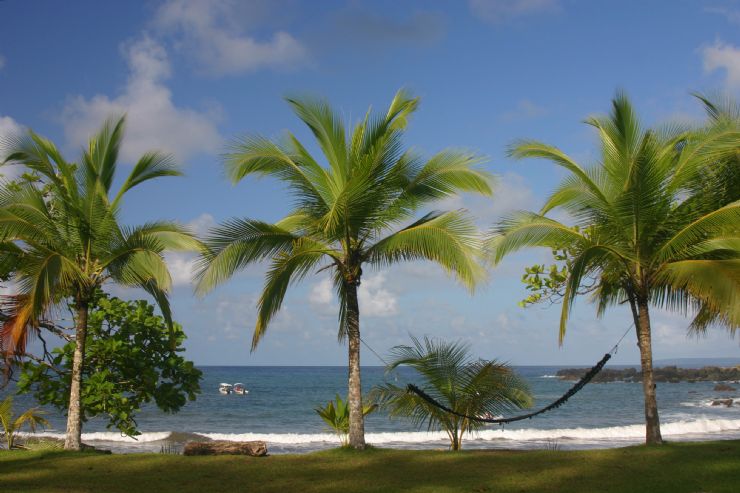
Palm Trees aligned on beach in Corcovado Nat. Park
What’s even more monumental and extraordinary is that Costa Rica is home to plant and animal species that are endangered. Through the country’s preservation efforts, species like the Leatherback Turtle, the Scarlet Macaw, the Golden Toad and more, have a real chance of increasing their numbers so they can be removed from the endangered list. These statistics make Costa Rica look great on paper, but the country looks even better in person. All of those numbers equal a diversity that is so full of wealth that it is hard to match anywhere in the world.
The Environments of the National Park System of Costa Rica
The reason that Costa Rica is able to have such rich diversity with its plants and animals is because the country houses a number of different environments, and the national parks protect those environments. From swamps to rainforests, and many environments in between, Costa Rica’s protected parks and reserves are areas that are honored and studied for its geological and geophysical incitement. These enviable environments include coral reefs, swamps, forests, and active volcanoes with hot springs. Within these environments, there are sub environments that include different types of forests, including deciduous forests, rainforests, cloud forests, swamp forests, and riparian forests; and swamps including mangrove swamps and herbaceous swamps.
There are also beautiful sights to behold, like caves, mountains, beaches, and waterfalls. Scientists are drawn to the area to study historical and archeological sites alike, including battleground remnants. There is a little something for everyone in Costa Rica. The country’s property even includes islands where the brown pelican nests and beaches where the sea
turtles can flock to lay their eggs – and all of this land is protected, which means that these animals are protected.
The Parks of the National Park System of Costa Rica
The parks of Costa Rica are home to many natural wonders, including active volcanoes, limestone caves, tall mountains, and craters. Though it was very hard for me to choose, I was
able to put together this list of my favorite Costa Rican national parks.
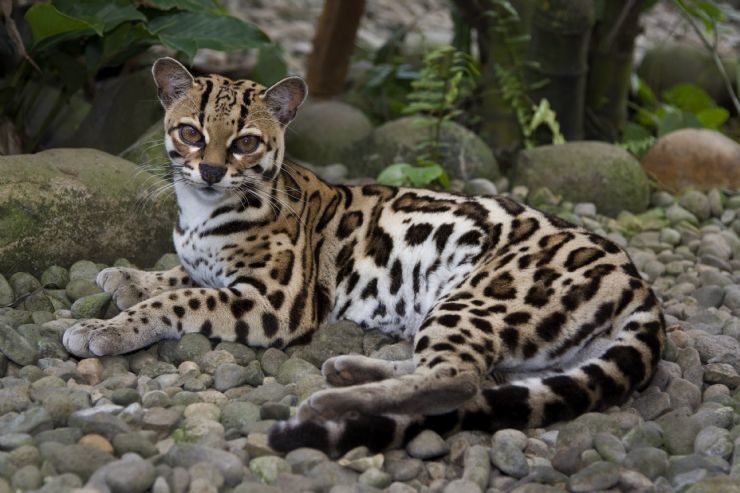
Margay on a trail in Corcovado National Park
Located on the Osa Peninsula, this is one of my favorite spots in the entire country. This area is vast, wild, and untamed, and it is just what every adventurer has ever wished for. This area, though remote, is a protected tropical lowland rainforest. This area alone boosts an incredible ecosystem number...thirteen. Overall, the park covers 41,000 hectares. A great place to spot of 600 species of animals, I secretly actually head her to check out the trees...500 species of them! This national park is also a great place to hike, either in the rainy or dry season. If you’re new, I recommend a guided tour. This national park is easy to get to, with two main entrance points through popular towns Puerto Jimenez and Drake Bay.
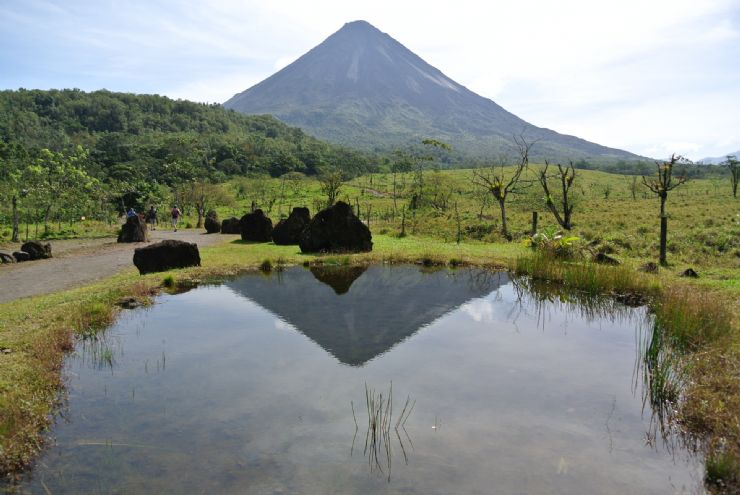
Arenal Volcano reflection on lake at Arenal Volcano National Park
Though the Arenal Volcano was once thought to be dormant, it actually erupted in 1968. While you might think this would scare people off, it actually boosted tourism. Since the volcano erupt with life, it has removed active, the most active in the country in fact, and has continued to draw in tourists. The park itself encompasses 12, 016 hectares, and is home to another volcanoes as well. While visiting, I love to hike the lava trails and take in the beautiful views. This protected area is also home to Lake Arenal. This lake is important to the country, as it generates 40% of the hydroelectric power.
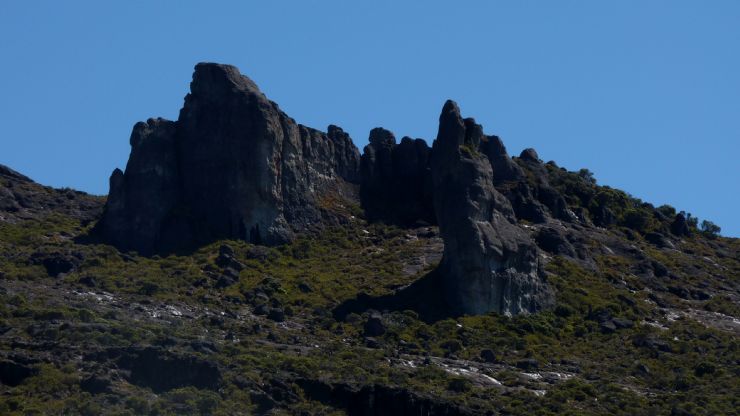
Chirripo Peak Crestones
When in Costa Rica, I recommend that you make it to this national park, which protects 50,10 hectares. One of the most spectacular sights that you will see is a mountain, but it is not just any mountain, it is the highest mountain in the country. Cerro Chirripo isn’t just tall, it is staggering. I have never felt so small as when I look up at this majestic mountain, which is 3,820 meters above sea level. Another reason that I really like to visit this area is because it is away from the hustle and bustle of the more touristy areas. I like to come here and spend some time in the quiet, enjoying a few good cups of coffee and a few good meals while I enjoy the gorgeous scenery. The main entrance for this park is in San Gerardo de Rivas.
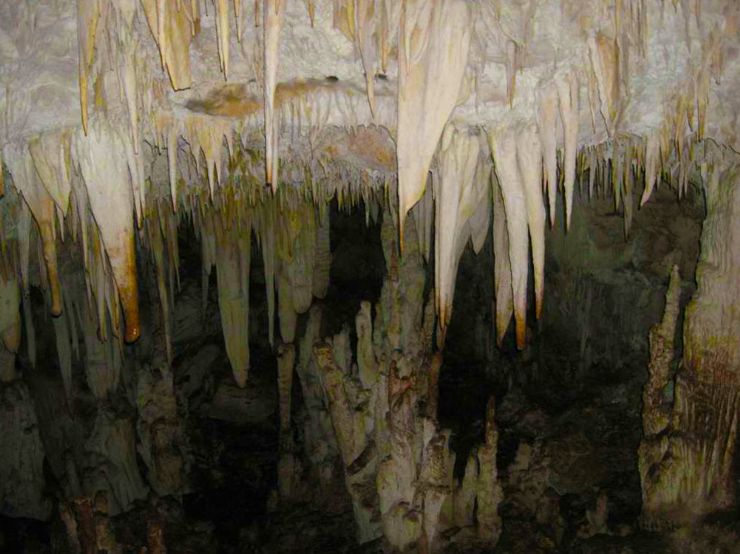
Stalactite in Barra Honda's caves
This place tugs at the adventurer side of me. The limestone caves that were cut out from the mountains by strong currents are fun to explore. I like to go spelunking in the caves – there are more than 40! – and they are still in good enough condition that they are safe for my adventures. I never go without a guide though; some of the caves go down as far as 780 feet! I don’t want to be down that far without someone that is familiar with the caves, and it is also legally required for you to go through the parks service to be able to explore the caves. Once I am tired out from exploring the caves, I like to take a day or two to hike the trails and enjoy the wildlife. There are always some great animals to see, like howler monkeys! Did I mention that you can actually spend a night in the park, with a bed to sleep on? It’s a great experience!
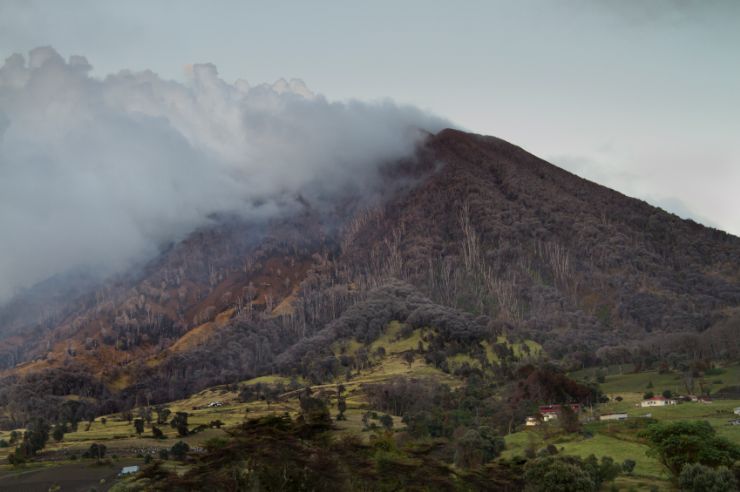
Turrialba Volcano smoking over ash covered trees
If you are looking for a park that isn’t crowded, Turrialba Volcano National Park is your spot. It is obviously intriguing since, you know the whole volcano thing, but it is one of the areas with the least amount of tourist traffic. The volcano hasn’t erupted in over 130 years, and you can also see at least three other volcanoes on the horizon. This area is not as developed as other areas, so it is not as easy to get to, but you can take a bus to Santa Cruz and then find your way up the summit. If you are going to be in the Cartago Province, you should definitely add this spot to your bucket list.
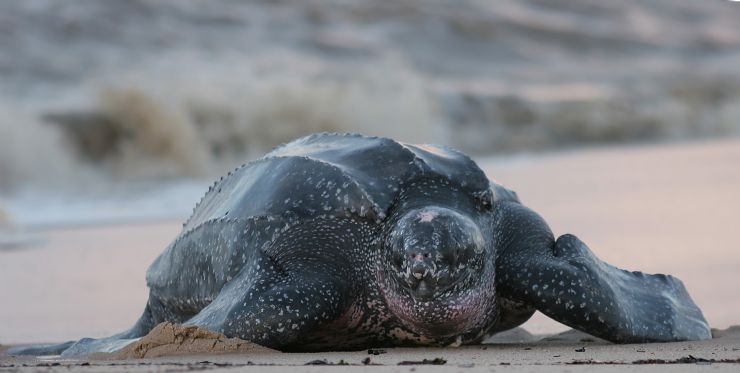
Leatherback Turtle coming out of ocean
This is one of the most special places in Costa Rica, as it is not just a sea turtle nesting site, it is the most important in Costa Rica. This park is located in Guanacaste province, this site was created with the intention of protecting the Leatherback Turtles, and has become an invaluable site. This endangered species now has a protected area to lay its eggs. The park itself encompasses 445 hectares, and includes both swamps and shorelines. There are also four beaches that you can access from the park. The park is not the easiest to get to, but there are more difficult places too. You should fly into Liberia, and plan to have a long road trip too.
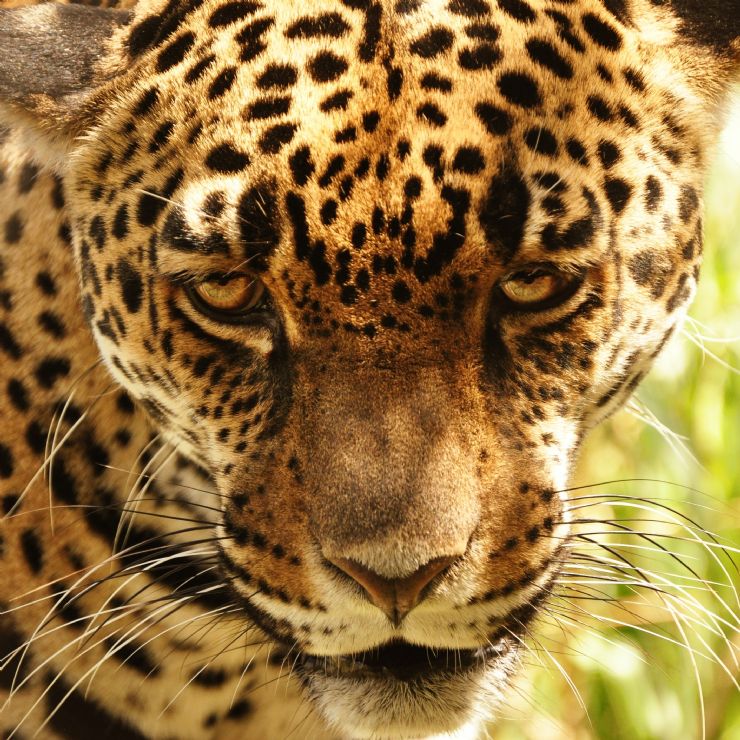
The steel eyes of a Jaguar in Costa Rica
The final national park on my list, which I am sad to see come to an end, is La Amistad International Park. This area is massive, and encompasses 500,000 acres of Costa Rica. This area is so awesome, it was even designated as a Natural World Heritage Site in 1983 by UNESCO. The craziest fact about this area is that it is believed that two thirds of all of the amazing wildlife in my county can be found in this area. This protected area is also mostly unexplored, which makes me feel like I have been challenged to venture deep into the park. But, I will leave it to the experts, as should you. Hire a guide to help you through the trails, as many of them are unmarked. You can get here by way of San Jose. Once you arrive, you’ll take a road trip to the park. There is a fee to enter the park.

